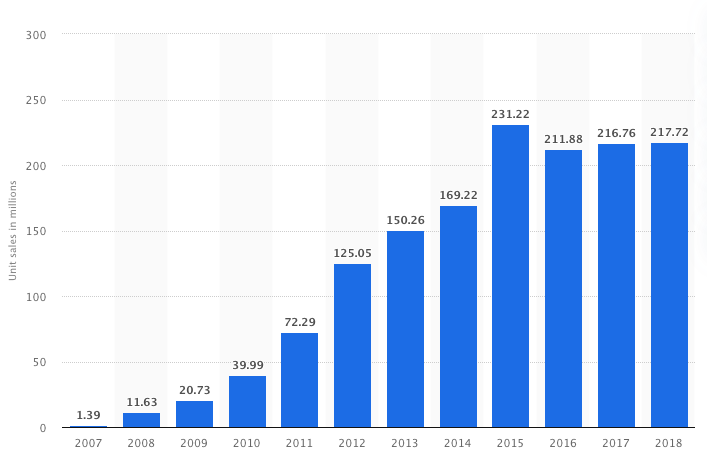The Rule Of 40: Which Side Are You On?
In the early days, a company with solid product/market fit and a great team will grow extremely fast. Revenue growth can be 1,000+%. But as a company becomes established, things come back to earth. Tripling revenue when you have $50k in revenue is a lot easier than tripling revenue when you have $50MM in revenue. Over time, the company will eat up all the low hanging fruit. Competitors will enter the space and apply pricing pressure and reduce win rates. Scaling becomes even more difficult. Things just start to slow down.
This flattening of growth is nothing to be ashamed of. It's a natural curve for any product or company — even the iPhone's growth has flattened.
Apple iPhone worldwide unit sales from 2007 to 2018 (in millions)
The way to break out of this natural flattening is to innovate. As Jeff Jordan says, “to add layers to the cake.” But eventually, even the greatest companies will see their growth rates begin to level off.
To maintain a high valuation despite slowing growth rates, companies will often point their energy towards becoming profitable or increasing profitability. One of the biggest challenges of a maturing company is this: should we step on the gas and continue to grow like crazy, or should we shift our focus to profitability?
The Rule of 40 provides an excellent framework for how to think about this question. The Rule of 40 states that a company's growth rate + profit margin (EBITDA) should exceed 40%. Companies that can stay above 40 will continue to be on the high end of valuations — 10x, 20x, 30x revenue multiples. According to a study done by Bain, software companies that are above 40 have valuations that are double those that fall below the line.
So as growth slows, it's useful for executives to ask, what side of the Rule of 40 do we want to be on? That is, are we going to continue to achieve the 40% via revenue growth or do we need to begin focusing on profitability.
The Rule is just a framework; it shouldn’t be taken as gospel. But it provides an extremely useful framing for how to think about one of the most challenging questions high growth companies face.
